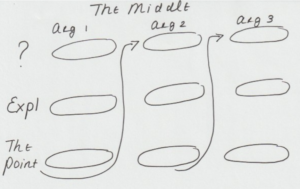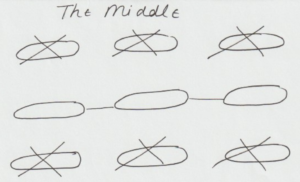Do you get confused looks during your presentation? This is what you can do about it!
As an expert you have a lot of knowledge. Each and every day, perhaps already for years, you are into your subject. You know how complicated things can be and in what way everything is connected. Just because you know so much, you often tend to get caught up in the content.
That’s entirely normal. Unfortunately, as a consequence of this, you may end up standing on an island with your great treasure of knowledge whilst presenting. The content stays with you and can’t reach the audience, let alone sink in.
How could you, as an expert, easily reach your audience? So, you won’t get glazed looks anymore. Instead, your audience will effortlessly remain captivated from start to finish.
How do you make sure your information really does sink in? So, your audience will understand the essence of your story and will be able to retell it?
In this newsletter you can read how the simple 3-stage method can really make the difference!
What does this method mean?
To explain this, we first need to look at why a good presentation consists of 3 parts? That is a beginning, a middle part and an ending. Just like books, plays and movies. This is for a good reason, of course. It’s what our brain needs. Every part has its own function.
Regarding a presentation, the beginning is about warming up the audience and preparing them for what’s about to happen, to make them understand and to raise interest.
Then, in the middle part, you provide the information and tell the things you promised in the introduction.
After this, we’re still not done. Because, the ending is essential for the audience, to let the middle part sink in. A short summary and the conclusion.
In short, at macro level, the audience needs these parts: the beginning, the middle part and the ending.
So, why don’t we use this iron-strong structure at micro level?
For every part of your middle part of your presentation or for a PowerPoint slide?
What does this mean in practice?
You get the audience “on board” super-fast using a short question.
For example:
“And I can hear you think, why is this the best approach?” (Introduction)
Afterwards, you tell the reason why this approach is the best one.
“Now that’s because…” (Middle part)
And then you seal it. You finish by proving your point.
“In conclusion: approach B gives more added value, because of its possibility of reuse.” END of sentence. (Ending)
And you can proceed to your next part of your middle part of your presentation.
“But, how exactly does reuse work in reality?
By using this 3 stage method (question, explaining and making the point), you wrap your content into 2 layers of explanation, which your audience direly needs.
The question:
1) You don’t dive into the content straight away, but you give structure and you make your audience curious instantly by asking the key question, which you’re going to answer with your content. In short: you give structure and you arouse interest at the same time.
The point:
2) You make “the point” after your explanation. Everything comes together in an ending statement which makes the former explicit and clear once more. You briefly repeat what you explained before, only in other words.
As an expert you often think, the conclusion of this is logical, I can stop here. But that is not enough for the audience, trust me. They need you to make the inference and to put everything together. Certainly, if the prior needed some time and explanation.
Report & Presentation
The image below shows that piling up content on top of content is exhausting for the audience. As if you’re reading a report that’s very dense. You’re piling up so much content and this often happens to an expert unnoticed.
But, your role as an expert in a presentation is more to be a GUIDE for your audience. Your role is to be explanatory. And you do that by adding the just explained 2 layers!!
Give your audience what they need to take in your content!
Even more benefits:
The additional benefit is that your presentation will become a lot more “conversational” this way. As if you’re in a conversation with your audience, instead of only sending information on top of information in their direction. Your presentation is more “interactive” and hooks better on to your audience because of this. You take them along step by step.
It’s also easier for you as a speaker. You move very logical and natural from one section to another. The presentation seems to be unfolding itself naturally.
Where does it usually go wrong?
As experts we tend to only apply the middle part (see image below), because we reason from pure content, piling up content on top of content, instead of thinking about what the audience needs to really take in the content (the 3-steps method).
We think ‘We told them the content, right? Done’. On to the next point. I don’t have to do anything else, do I?
Not realizing that the audience has to constantly be triggered (ASKING A QUESTION) to stay hooked on to the presentation and that the audience has to be put on the right track (STRUCTURE), before the content can sink in.
And clearly needs points (MAKE YOUR POINT). Making the explanation part explicit again, in other words. The audience needs this to go along on the trip with you.
An example:
In short… <FULL STOP>
In a nutshell… < FULL STOP >
In other words… < FULL STOP >
That means… < FULL STOP >
Without the ending and making the point, your knowledge may have reached your audience, but it did not sink in yet.
Besides, making the point with a pause gives structure. Ohh, we’ve wrapped up this part, is what the audience feels. Now we’re moving on to the next part.
Instead of stitching all of these parts together, which leads to the fact that where something ends and begins again is not clear for the audience. And the information becomes one big knit. Causing the audience to, you know where this is going……….. tune out or get a glazed look on their faces.
The best radiofrequency
You could see the 2 layers of explanation, which you wrap your content in, as the radiofrequency that leads you to communicate with your audience in the best and the clearest way.
Why? It’s the helicopterview, the explanation, in which you hover above the content and that’s your bridge to the audience!
Add these layers and the content will slide in way better, will also sink in better, and you’ll see: glazed looks are in the past!
Good luck!
This content is from my newest E-book: “Make your business presentation very clear, fascinating and memorable in 5 steps!” You can receive the free E-book by sending an e-mail to info@presentingwithimpact.nl.
Translated by Wies Linssen.






